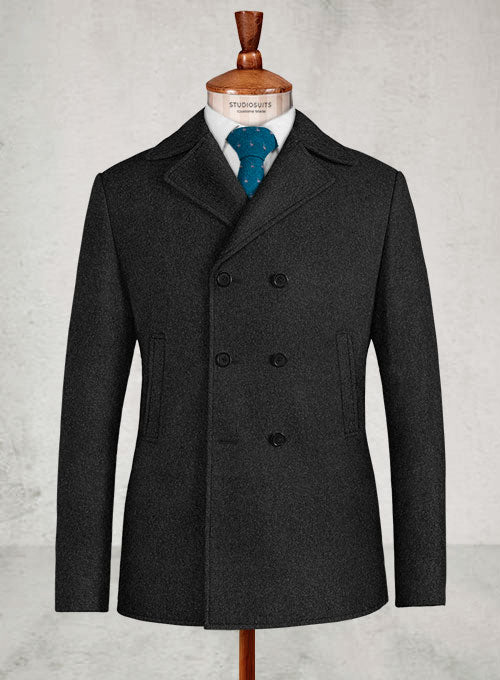A pea coat is a stylish form of outerwear that's perfect for most suits. Whether you're wearing a linen or wool suit, you can probably accessorize it with a pea coat. Also known as a pilot jacket, it's a type of double-breasted coat that's characterized by broad lapels and large buttons.
Pea coats have been around for centuries. They originated in the European Navy where they were worn sailors aboard ships. Since then, pea coats have become a staple fashion accessory that's commonly worn with a suit. How do you choose a pea coat for a suit exactly?
Match the Color With Your Trousers
Suit etiquette 101 requires matching your jacket -- or in this case, your pea coat -- with your trousers. In other words, these two garments should feature the same color. If you're wearing a black suit with black trousers, you should choose a black pea coat. If you're wearing a navy suit with navy trousers, on the other hand, you should choose a navy pea coat.
With your pea coat featuring the same color as your trousers, you'll create a more cohesive suit. Both the top half and bottom half of your outfit will match, resulting in a cleaner and more cohesive appearance. If you choose a pea coat in a different color than your trousers, you may inadvertently create an awkward-looking suit outfit.
Go With a Double-Breasted Style
It's recommended that you choose a double-breasted pea coat. Double-breasted pea coats are characterized by the presence of two columns of buttons on the front. They offer a more traditional and classic appearance, making them a popular choice for suits.
While most pea coats are double breasted, some of them are single breasted. Single-breasted pea coats don't have two columns of buttons. Instead, they have a single column of buttons. There's nothing necessarily wrong with double-breasted coats and jackets. Pea coats, however, are known for their double-breasted front. Ever since they were first invented, pea coats have been designed with a double-breasted front, making this style a traditional and popular choice.
Choose the Right Fabric
Don't forget to consider the fabric when choosing a pea coat. Wool is a common fabric used in the construction of pea coats. Pea coats made of real wool are soft, warm, comfortable and easy to maintain. Wool is by far the most popular fabric in which pea coats are made. Regardless of the color or style, you can't go wrong accessorizing your suit with a wool peacoat.
You can also find pea coats made of cotton. Cotton pea coats are typically lighter and thinner than their wool counterparts. These qualities make them ideal for the summer months when it's hot outside. During the cooler seasons, though, you want to stick with a wool pea coat.
Here are some of the most common fabrics in which pea coats are made:
- Wool
- Cotton
- Linen
- Tweed
- Corduroy
- Linen
Keep in mind that different fabrics have different requirements regarding cleaning and maintaining. Some of them can be machine washed, whereas others must be dry cleaned. Therefore, you should read the care tag or care instructions when choosing a pea coat.

High-Quality Buttons
Being that the buttons on pea coats are typically larger than those found on other coats and jackets, you should choose a pea coat with high-quality buttons. High-quality buttons are stronger, better-looking and more durable than cheap buttons.
Choosing a pea coat with high-quality buttons is particularly important for double-breasted styles. As previously mentioned, double-breasted pea coats have two columns of buttons. In other words, they have twice as many buttons as single-breasted pea coats. If the buttons are low quality, they may fall off or otherwise sustain damage. You can avoid mishaps such as this by choosing a pea coat with premium, high-quality buttons.
Look for Lining
Depending on when and how you intend to wear it, you may want to choose a pea coat with lining. Lining, of course, is a thin layer of fabric that's added to the interior. Most coats and jackets aren't lined with the same fabric from which they are made. Rather, they are lined with a separate, secondary fabric.
With lining, your pea coat will offer a higher level of comfort when worn. Even if your pea coat is made of wool, you can get it lined with a separate fabric. There are viscose-lined pea coats, for example. Viscose is a type of cellulose fabric that's known for its silky-smooth texture.
Lining also offers additional warmth. If your pea coat has lining, it will act as a shield against the cold weather. You wear any type of pea coat during the winter. Viscose-lined pea coats, though, tend to offer greater comfort than those without any lining. The thin layer of fabric lining the interior will insulate your body so that you stay warm.
Check the Size
Always check the size when choosing a pea coat to wear with a suit. You can't expect to create an attractive suit outfit if your pea coat doesn't fit. Maybe it's too big, or perhaps it's too small. Regardless, choosing a pea coat in the wrong size is a serious fashion faux pas that should be avoided.
Fortunately, you don't have to try and guess the right size when choosing a pea coat. You can order a custom-sized pea coat. Custom-sized pea coats, such as those sold here at StudioSuits, are made according to your measurements. Rather than choosing a generic size, you can specify your body measurements. The pea coat will then be designed according to these measurements. As a result, it will fit perfectly.
In Conclusion
You can wear any formal coat or jacket with a suit, and pea coats are no exception. Pea coats, in fact, are a popular choice of formal outerwear. They are comfortable and stylish, and they naturally flow with most suits. Just remember to choose the right pea coat by following the tips outlined here.



